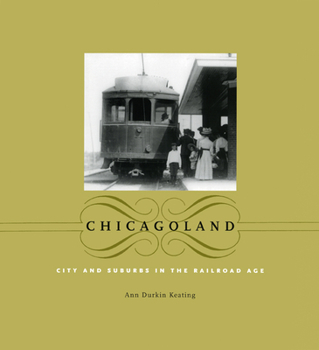Chicagoland: City and Suburbs in the Railroad Age
Formed by images of crowded city streets and towering skyscrapers, our understanding of nineteenth-century Chicago completely neglects the fact that the city itself was only the center of a web of neighborhoods, farm communities, and industrial towns--many connected to the city by the railroad. Farmers used trains to transport produce into the city daily; businessmen rode the rails home to their commuter suburbs; and families took vacations mere miles outside the Loop. Historian and coeditor of the acclaimed Encyclopedia of Chicago, Ann Durkin Keating resurrects for us here the bustling network that defined greater Chicagoland. Taking a new approach to the history of the city, Keating shifts the focus to the landscapes and built environments of the metropolitan region. Organized by four categories of settlements-farm centers, industrial towns, commuter suburbs, and recreational and institutional centers-that framed the city, Chicagoland offers the collective history of 230 neighborhoods and communities, the people who built them, and the structures they left behind that still stand today. Keating reanimates nineteenth-century Chicagoland with more than a hundred photographs and maps; we find here the taverns, depots, and way stations that were the hubs of the region's vibrant, mobile life. Keating also includes an appendix of driving tours so readers can see this history for themselves. Chicagoland takes us into the buildings and sites that are still part of our landscape and repopulates them with the stories and characters behind their creation. The result is a wide-angle historical view of Chicago, an entirely new way to understand the region.
Format:Paperback
Language:English
ISBN:0226428826
ISBN13:9780226428826
Release Date:November 2005
Publisher:University of Chicago Press
Length:296 Pages
Weight:1.46 lbs.
Dimensions:0.7" x 8.5" x 9.2"
Related Subjects
HistoryCustomer Reviews
1 rating
Understanding the roots of metropolitan Chicago
Published by Thriftbooks.com User , 15 years ago
The subtitle understates the scope of this book, which also covers Chicago and suburbs in the plank road age, the canal age and even the highway age. It links rural sites to the metropolitan region and offers critical tools for understanding the types of development that form the whole -- not only the downtown, or the city's community areas, but places that began as agricultural trade centers, satellite cities, railroad commuter suburbs and recreational towns. I was particularly please to see Keating sketch the history of picnic grounds and beer gardens that used to dot the fringes of the city, the best known of which evolved into Riverview Park.





